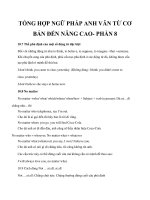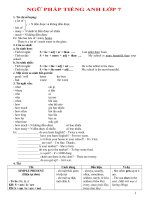Tổng hợp ngữ pháp anh văn 5
Bạn đang xem bản rút gọn của tài liệu. Xem và tải ngay bản đầy đủ của tài liệu tại đây (70.44 KB, 5 trang )
<span class="text_page_counter">Trang 1</span><div class="page_container" data-page="1">
<b>TỔNG HỢP NGỮ TIẾNG ANH LỚP 51.Động từ “like” </b>
<b>Khẳng định :</b>
I/You/We/They + like + V-ing She/He/It + likes + V-ing
<b>Ex: </b>
I like reading. She likes reading
<b>Phủ định: </b>
I/You/We/They + don’t + like + V-ing She/He/It + doesn’t + V-ing
<b>Ex: </b>
I don’t like reading She doesn’t like reading.
<b>Câu hỏi:</b>
Do + you/we/they + like + V-ing? Yes, I/we/they do
No, I/we/they don’t
Doesn + she/he/it + like + V-ing? Yes,she/he/it does.
No, she/he/it doesn’t
<b>Ex: </b>
Do you like reading? Yes, I do// No, I don’t . Does she like reading?
Yes, she does// No, she doesn’t
<b>2.Thì hiện tại tiếp diễn: </b>
I’m playing chess. She’s playing chess. We’re playing chess.
<b>Phủ định: </b>
I’m + not + V-ing
She/He/It + isn’t + V-ing We/They/You + aren’t + V-ing
<b> Ex: </b>
I’m not playing chess. She isn’t playing chess. They aren’t playing chess.
<b> Câu hỏi: </b>
Are + you/we/they + V-ing? Yes,I am// Yes, we/they are. No, I’m not// No, they/we aren’t. Is + she/he/it + V-ing?
Yes, he/she/it is. No, he/she/it isn’t.
No, she isn’t
<b>3.Thì hiện tại đơn: </b> She plays games. They study English.
I’m not a student. She isn’t a teacher. They aren’t workers.
<b>Ex:</b>
</div><span class="text_page_counter">Trang 2</span><div class="page_container" data-page="2">I + don’t + Vo
She/He/It + doesn’t+ Vo They/We/You + don’t +Vo
I don’t have a hat . She doesn’t eat Pho.
They don’t like playing volleyball.
<b>Câu hỏiĐộng từ tobe: </b> Yes, he/she/it is. No, she/he/it isn’t
<b>Động từ thường: </b>
Do + you/we/they + Vo ? Yes, I/we/they do. No, I/we/they don’t. Does + she/he/it + Vo? Yes, she/he/it does. No, she/he/it doesn’t,
<b>Ex: </b>
Are you a student? Yes, I am// No, I’m not. Is she a teacher?
Yes, she is// No, she isn’t.
<b>Ex: </b>
Do you eat Pho?
Yes, I do // No, I don’t Does she play games?
Yes, she does// No she doesn’y
<b> *Lưu ý</b>
<b>Cách thêm “-es” </b>
<b>Động từ thường kết thúc với “-o, -s, -z, -ch,-x, -sh” </b>
<b>Ex: go goes; mix mixes ; watch watches, brush brushes </b>
<b>Thêm trạng từ chỉ mức độ tần suất : always (luôn luôn), sometimes (thỉnh thoảng), never (không bao giờ) ở trước động từ thường và sauđộng từ tobe. </b>
<b>Ex: She always watches TV. She is always beautiful. 4.Lượng từ: </b>
<b>Countable noun (Danh từ đếm được): danh từ có thể kết hợp với số đếmEx: a chair, two chairs; a book, three books,…. </b>
<b>Uncountable noun (Danh từ không đếm được) danh từ không thể kết hợp với số đếm. </b>
<b>Ex: water, coffee, rice </b> cái tuy nhiên bắt đầu với danh từ -u, -e, -o, -a, -i)
Some (dùng được cho cả danh từ không đếm được)
Ex: some bread, some meat, some juice,…..
</div><span class="text_page_counter">Trang 3</span><div class="page_container" data-page="3">Some (dùng cho danh từ đếm được với số lượng là từ 2 cái trở lên)
Ex: two melons = some melons Three oranges = some oranges
<b>5.So sánh HƠN và So sánh NHẤT với tính tử ngắn: </b>
5.1.Tính từ ngắn (Short adjective): là tính từ chỉ có một âm tiết khi phát âm. Ex: big, old, tall, short,….
5.2.Công thức
<b>So sánh hơn:S + tobe+ Adj -er + than </b>
Ex: She’s taller than me.
<b>So sánh nhất: S + tobe + the Adj + -est + (N) </b>
Ex: He’s the shortest student in my class.
Có 2 âm tiết, nhưng tận cùng là ‘
y” <sup>-y → -i + er </sup> <sup>Ex: happy → happier </sup> hungry —> hungrier Kết thúc với nguyên âm (u,e,o,a,i)
+ phụ âm <sup>gấp đôi phụ </sup>âm + er <sup>Ex: big —> bigger</sup>
<b>So sánh nhất đối với Tính từ ngắn </b>
Dạng tính từ bình thường +est slow → the slowest
Kết thúc với “-y” -y → “-i” +est happy →the happiest
</div><span class="text_page_counter">Trang 4</span><div class="page_container" data-page="4">Kết thúc với nguyên âm (u,e,o,a,i) +
phụ âm <sup>gấp đôi phụ âm +</sup>est <sup>big → the biggest</sup>
<b>Một số tính từ so sánh hơn và so sánh nhất dạng đặc biệt : </b>little (ít) less (ít hơn) least (ít nhất)
<b>6.Động từ “must và mustn’t” Must +Vo</b>
They must do our homework. She must do her homework
<b>Mustn’t + Vo</b>
You musn’t walk your dog here. They musn’t talk in class
<b>7.THERE WAS ……… or THERE WERE………. </b>
<i><b>There was + (not) + ……….. : Sau there was sẽ đi kèm với Danh từ số ít , dùng ở trong thời điểm quá khứ. </b></i>
<i><b>Ex: There was a park in our town fifty years ago. </b></i>
<i><b>Ex: There wasn’t a shopping mall in our town fifty years ago. </b></i>
<i><b>There were + (not)………: Sau there were sẽ đi kèm Danh từ số nhiều, dùng ở torng thời điểm quá khứ. </b></i>
<i><b>Ex: There were some trains one hundred years ago. There weren’t any planes two hundred years ago. </b></i>
<b>Lưu ý: </b>
<b>“lots of” , “some” dùng với “There were” </b>
“any” dùng với “There weren’t”
She was beautiful then, They were workers.
She had a book when she was a baby.
</div>








